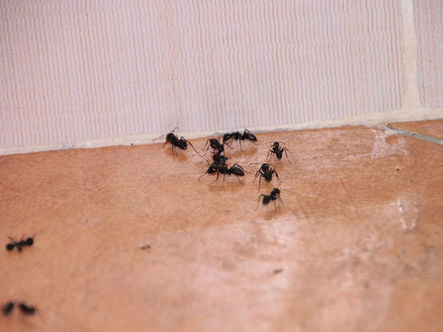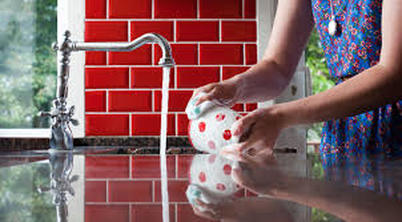
In all honesty, it's impossible to bug proof your home completely. Like it or not, some insects will find a way into your house. But you don't have to make it easy for them! Invest a little time in these home maintenance and housekeeping tasks, and you will greatly reduce your chances of a major insect infestation.
When attempting to bug proof your home, you need to do two basic things: prevent insects and spiders from getting inside, and eliminate bug habitat in your house.Your goals are to keep as many bugs out as possible, and to make your house inhospitable to the few that find their way in.
1. Install and maintain screens on all doors and windows.
If you don't have screen doors on your home, install them. Repair or replace any torn or damaged window screens. Use fine mesh screening to prevent all but the tiniest insects from entering your home.
2. Seal around all doors.
If air and light can pass through, bugs can get in. Install tight-fitting thresholds and door sweeps to the bottoms of exterior doors. Use door seals to fill the gap around the sides and top of each door, too.
3. Seal cracks in your home's foundation, exterior walls, and fascia boards.
Any crack in the exterior walls of your home is a welcome sign to insects. Grab a tube of caulk and inspect your home from top to bottom. Seal any cracks you find.
4. Seal around utility lines and appliance vents.
Insects may enter your home through tiny gaps around your dryer vent, gas line, or even telephone line. Caulk crevices on the outside of your home. You might also want to seal these areas from the inside using a spray foam product.
5. Install critter-proof mesh on vents in attics and crawl spaces.
Raccoons, squirrels, mice, and even birds may make themselves at home in crawl spaces and attics if you don't install barriers to keep them out. These animals may carry mites, fleas, or other pests that will then infest your home.
6. Eliminate moisture by fixing leaks.
Most insects (except for those that live in arid environments) require a certain amount of humidity to survive. Any source of moisture can attract them. Fix any plumbing leaks, however minor, promptly. Even condensation on pipes can drip and create suitable places for bugs to live. If your basement or crawl space takes on water during heavy rains, you're asking for insect problems. Install a proper drainage system, and run dehumidifiers if needed.
7. Keep a tidy kitchen.
Where there's food and water, bugs will happily make themselves at home. Do all you can to keep your kitchen clean. Wipe up crumbs, sweep or vacuum the floor, and clean up spills right away. Don't leave dishes in the sink overnight. Clean out the toaster and microwave regularly. Scrub down your stovetop every day. Throw away food scraps and packages.
8. Keep food sealed up tight.
If you have a kitchen pest problem, you'll need to take drastic steps to eliminate food sources for the offending insects. Store cereals, grains, rice, and other pantry items in air tight containers. Keep opened food containers in the refrigerator.
9. Get rid of clutter.
Insects need places to hide, and a cluttered home is a bug's paradise. Recycle unneeded boxes and newspapers promptly. Keep laundry in clothes hampers. Keep your floor clear of belongings, and put things away after you use them.
10. Clean up after your pets.
Some bugs like pet food, and others like pet waste. Clean your pet's food dishes regularly, and don't leave extra pet food accessible. Store dry food in air tight containers. Scoop and clean your cat's litter box daily. Wash your pet's bed or favorite blanket regularly.
11. Take the garbage out frequently.
If you can smell it (even a little), it's going to attract bugs. In fact, insects are much more sensitive to odors than we are, so even if you can't smell it, it may attract bugs. If you're really worried about insect pests in your home, empty your garbage often. Line your cans with plastic garbage bags, and tie them tight before you take the bags out for pick-up.
12. Rinse recyclables thoroughly.
Your recycling can is a smorgasbord for bugs. Soda cans, beer bottles, and pet food cans will all attract insects if they aren't rinsed out thoroughly.
13. Scrub your trash bins.
Even with your garbage in plastic bags, there's bound to be a spill or torn bag now and then. Scrub out all of your trash bins to eliminate smells and sticky substances that may attract insects. Several times per year, use a solution of bleach to clean your outdoor cans thoroughly, especially if you keep them close to your house.
14. Clean up your yard.
Mulch, leaf litter, and garden debris can all harbor insects. Keep mulch away from your home's foundation, and clean up any accumulated organic matter. Mow your lawn regularly, and keep it short near your house. Pull annuals out at the end of the growing season, and trim back perennials as appropriate in the fall.
15. Prune trees and shrubs.
When trees and shrubs come in contact with your home, they function as highways for insects on the move. Keep tree branches pruned so they don't rest on your roof. Prune shrubs away from windows and doors.
Author: Debbie Hadley
Original Article: http://insects.about.com/od/insectssociety/a/15-Ways-To-Bug-Proof-Your-Home.htm


 RSS Feed
RSS Feed
